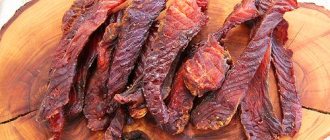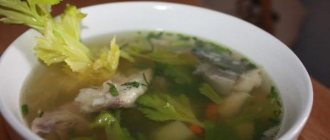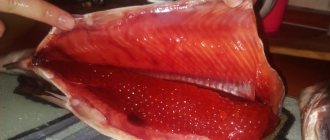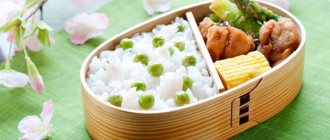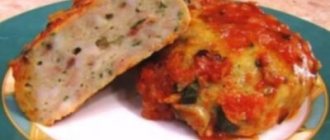Reviews (2)
3
Prepared by: Marina Krasilnikova
09/07/2019 Cooking time: 30 min
| Save | I cooked) | Estimate |
With desserts in Asian cuisine, everything is much simpler than in European cuisine, for example, but also more intriguing. I want to show you how to make Japanese Mochi cakes based on rice flour. Remember!
How to make Japanese Mochi Cakes
These are the basic ingredients for the mochi base. I use blueberry juice as a dye.
Combine rice flour with powdered sugar.
Pour blueberry juice into water and add to dry ingredients.
Mix everything thoroughly. The dough should be very liquid. If it is a bit thick, you can add a little more water.
Cover the bowl with cling film and microwave. I set it to maximum power for 1.5 minutes. Afterwards I look at the consistency and leave it for another 1 minute.
The flour will boil and you will get this sticky mass. Mix thoroughly and cool slightly.
Sprinkle the work surface with starch.
Pinch off a piece of rice dough, place it on the starch and smooth it out.
Place the filling in the center. Mine is peanut butter.
And seal it carefully. A Mochi cake can be this round if the filling is soft or in the shape of a truffle if you put, for example, strawberries in the middle.
As soon as the work is finished, you can immediately try what happened. Bon appetit!
What is Japanese mochi and what do you eat it with?
Rice cakes with filling and original taste - that's what mochi is. Although the shape of the dessert is more like small round pies or buns, unlike baked goods familiar to Europeans, they do not contain flour. The basis is a special variety of rice with a high gluten content - the same as for sushi. It is thoroughly ground to a homogeneous paste, then steamed, ensuring that the mass becomes dense and sticky. After this, they begin to sculpt the pies - this process is called mochitsuki.
The variety of rice used for mochi has a slightly sweet flavor, so no sugar is added to the dessert. But they use sweet fillings. The most popular is red adzuki bean paste, but there are others, for example, matcha green tea powder, pieces of mango or melon, whole large strawberries, chocolate spread, etc. There is also mochi in the form of cookies (in this case, the rice mass acts as a filler for cookies) and in the form of ice cream.
The traditional dessert can be bought at any Japanese grocery store, but it is difficult to find it abroad. However, homemade mochi is especially popular among the Japanese. This is a must-have treat on the holiday table and one of the most common gifts. A sweet dish is certainly prepared for the New Year and distributed to all relatives, friends, and neighbors.
It is believed that in this way the wish of health and happiness is conveyed to a person. Sometimes one mochi is shared with the closest people - family members, which symbolizes the willingness to share troubles and joys, wealth and all the blessings of life with those who are dear.
Japanese pancakes Dorayaki
Dorayaki are honey sponge pancakes with a sweet filling, traditionally made from bean paste, however, there are many variations.
The name "dorayaki", which translates as " fried gong ", was given to the pancakes thanks to a legend that tells of a certain samurai who forgot his gong in the house of one of the local residents, who began to bake perfectly shaped pancakes with it.
- Cooking time: 1 hour total time, 8 hours to soak the beans and 2 hours to cook them.
- Tools and kitchen appliances: bowl, whisk, tablespoon, teaspoon, blender, saucepan, frying pan, spatula.
Required Products
For the test :
- eggs – 2 pcs;
- sugar – 50 g;
- liquid honey – 1 tbsp;
- soda – 0.5 tsp;
- water – 50 ml;
- flour – 130 g.
For filling :
- adzuki beans – 0.5 tbsp;
- sugar – 50 g.
Features of product selection
Adzuki beans are sold in stores and are prepared like all legumes: after pre-soaking in water overnight, they are boiled for about 2 hours.
Honey should be liquid. If it has already thickened, it should be heated in a water bath or in the microwave, but under no circumstances boil it.
How to cook Dorayaki: step-by-step recipe
Preparing the dough
- Mix eggs with sugar, add honey.
- Pour soda with water and add to the egg mixture.
- Add sifted flour to the dough and mix thoroughly with a whisk. After kneading, cover the dough with film and leave for half an hour.
The mass should be quite liquid, similar to pancake batter; if it turns out to be thicker, you can achieve the desired consistency by adding a little water.
Preparing the filling
- Blend the cooked beans with a blender, leaving 2-3 tablespoons of whole beans.
- In a saucepan, combine bean puree, whole beans and sugar, cook for 10 minutes to thicken and darken the mass.
- If the pasta starts to burn during cooking, you can add a little water to it.
Baking pancakes
- While the filling is cooling, start preparing the pancakes. Grease the frying pan with a small amount of oil, place small portions of dough equal in quantity and size and bake until golden brown.
- Turn over when bubbles appear on the surface of the pancake, indicating that it is more than half baked.
How to beautifully decorate and serve pancakes
Coat the pancake with the prepared paste, cover the top with the second one and press down a little, but so that the filling does not come out through the side slots.
Dorayaki is an everyday dish, they are not served on special occasions, however, if desired, the pancakes can be decorated with chocolate topping, whipped cream, green mint leaves, berries or fruits.
Cooking tips and tricks
- You should always let the dough sit for about half an hour between kneading and cooking so that the gluten is released from the flour and carbon dioxide in sufficient quantities enriches the dough with bubbles that appear as a result of the reaction of soda.
- Before baking pancakes, the frying pan must be well heated.
- To prevent the dorayaki from sticking, before baking the first batch, you should grease the surface of the pan with a small amount of oil and wipe off the excess with a paper towel.
- In order for the color of the pancakes to be uniform, the pan must be heated, and the pan itself must be dry, without excessive amounts of oil.
Video recipe for making Dorayaki
Japanese sweets made by the author of the video are dorayaki sponge pancakes. The technology for preparing the dough is shown step by step. Making the filling is demonstrated in all its subtleties. An interesting presentation of a traditional recipe, accompanied by the legend that gave the dish its name.
The Art of Wagashi
In Japan they say that wagashi is the most attractive part of the art of Japanese cooking. And this is, first of all, because each cake is made by hand using the fingertips of the skilled hands of the master and a piece of the soul that he puts into his creation.
Color, shape, size? The Wagashi will tell us everything the artist wanted to tell us. Just as a piece of music cannot be played the same way several times, it is impossible to create identical wagashi. The smell of wagashi is the smell of nature. All plants smell differently - rice, beans, mint and ginger, and the incomparable smell of green tea, familiar to every Japanese since childhood. It is the aroma of nature that we inhale when we bring wagashi to our lips.
For those who have a desire to express themselves in the culinary arts, it will not be difficult to prepare some varieties of wagassi
gold fish
The appearance of a delicacy for the Japanese means no less than the content. A striking example of this is pies filled with taiyaki in the form of a detailed fish. To achieve such highly artistic beauty, cookies are baked in special waffle irons. For our sweet tooth, it will most likely remind you of nuts with boiled condensed milk. Most often, the same bean paste, custard or melted chocolate is placed inside the fish. There are also unusual variations. The fish are baked with their mouths agape to be filled with ice cream, fruit and colored candy.
Ingredients:
- flour - 160 g
- chicken eggs - 2 pcs.
- sugar - 2 tbsp. l.
- milk - 200 ml
- vegetable oil - 1 tbsp. l.
- salt - 1 tsp.
- baking powder - 1 tbsp. l.
- Anko bean paste - 100 g
Beat the eggs with sugar until the mixture thickens and increases in volume. Then pour in milk with vegetable oil, sift flour with baking powder and salt. Beat everything with a mixer until a homogeneous, smooth consistency reminiscent of sour cream.
Lubricate the waffle iron cells with oil and heat them well. Fill with liquid dough and place about 1 tbsp in each cell. l. bean paste. Cover the waffle iron with a lid and press down a little. Fry the pies at medium heat in this mode: the first 30 seconds on one side, a minute on the other, then another 40-45 seconds on the first side. Once the fish are nicely and evenly browned, you can remove them.
Japanese cuisine for children
Recently, Japanese cuisine has become especially popular, which contains many delicious and healthy dishes. These include rolls - a traditional Japanese food. For a culinary master class in Japanese cuisine, you will most likely need the help of professional sushi chefs, who can be found in any sushi bar. They will bring all the necessary ingredients, including seaweed, rice, nori, ginger, sesame seeds, curd cheese, crab meat, shrimp and other fish delicacies for the filling.
Experts will not only show you how to transform sticky rice into attractive rolls, but will also tell you the differences between a thick roll and a thin one, and share secrets on how to choose fresh ingredients and how to properly cut the fish filling for sushi. From the proposed options, young sushi masters will be able to choose any culinary recipe they like for the master class.
Children's master classes immerse the child in an amazing and unknown world. If your child has not previously thought about the origin of many dishes, at a culinary event they will appear in a new light, shrouded in magic and creative inspiration. Be sure: after such a show, your child will enthusiastically begin to develop his culinary talents, helping you in every possible way in the kitchen.
About the benefits of Japanese desserts
Mochi is a great substitute for classic European desserts. Anyone who eats such sweets can be sure of getting the required amount of calcium. Rice also contains silicon, which can be called an element of longevity and health. The absence of a high fat content and yeast will also improve the well-being of those with a sweet tooth and will remain safe for their slim figure. You'll get a lot of protein and not too many calories.
Alternative Japanese Dessert Recipes
What Japanese sweets are popular and famous now? Their list is truly huge and includes:
- anmiju, which are jelly-like cubes with the addition of fresh fruit;
- botamochi - rice cakes with sugar and adzuki bean paste;
- wagashi - transparent (translucent) desserts prepared on the basis of agar-agar (a particularly popular type is translucent wagashi with the color of hydrangea, which is served in Japan for tea in early June, during the rainy season. They are served with green leaves that symbolize youth and the freshness of the surrounding nature);
- cakes made from adzuki bean paste, prepared in such forms as: flowers, fruits, figures of animals, birds, fairy-tale characters;
- daifuku – products with rice dough, sweet anko paste and fresh fruit;
- dango - a small wagashi cake made from sweet anko paste, served as a dessert on a thin wooden stick;
- yokan, which have several special varieties - for example, neriyokan, which is a red bean marmalade and is often served as a compliment to green tea during tea ceremonies. Its delicate sweetness goes well with the bitter taste of tea.
- mochi are glutinous rice cakes of the same name, the filling of which is made from adzuki bean paste;
- Kusamoti is a transparent green variety of mochi containing the Japanese wormwood yomogi;
- sakuramochi - mochi wrapped in a salted Japanese cherry leaf;
- manju – wheat flour-based sweets with azuki bean filling. They are prepared in several varieties: round balls with an impressive amount of filling, and in the form of small flatbreads with a layer of sweet grain beans;
- namagashi (one of the types of wagashi), served with koicha (this is a special thick tea). They are called “living dessert” because they cannot be stored. It is ideal to prepare dessert directly for immediate serving to guests;
- rakugan are hard sugar candies;
- Taiyaki are a type of imagawayaki, they are sculpted in the shape of a fish;
- uiro - steamed cakes made from sugar and rice flour, similar to mochi.
Look at the sites that post all the Japanese desserts with photos to decide what you will cook after practicing with the material on preparing mochi presented by KhozOboz. KhozOboz is confident that mochi, this magnificent Japanese rice dessert, will become inspiring for you to delight your family, friends and acquaintances every time with a variety of fillings and toppings of all kinds. Do it right now! It's so simple! Have a pleasant gastronomic experience!
Little joys of life
Mochi is often included in a variety of Japanese sweets, including the dainty and colorful ones used during the tea ceremony. Red, white and green hishimochi and pink sakuramochi are eaten at Hinamatsuri, the Doll Festival on March 3, and kashiwamochi, bean-filled cakes wrapped in oak leaves, are eaten at the Boys' Festival, Tango no Sekku, on May 5.
Rice cakes add a festive feel to various events in life. Red and white kohakumoti are given, for example, at school entrances and at weddings, and are also used to consecrate the frame of a house under construction.
Colorful hishimochi are used during the Doll Festival on March 3rd
The fern turns...
Warabimochi, or warabi-mochi, is a rather unusual Japanese dessert. In terms of taste and composition, it strongly resembles our native jelly, so dense that it can be cut with a knife. Starch is also used to prepare it, but it is unusual. It is extracted from the roots of the warabi fern. A very thick jelly is cooked on its basis, and when it hardens, it is cut into cubes and rolled in a breading of kinako - fried beans crushed into flour.
Ingredients:
- Warabimotiko starch - 70–100 g
- kinako - 3 tbsp. l.
- water – 400 ml + 1 liter
- sugar - 3 tbsp. l.
- powdered sugar - 1 tbsp. l.
- ice cubes
Combine warabimochiko and powdered sugar in a saucepan and add 400 ml of water. Place over medium heat and bring to a boil, stirring constantly. Then we reduce the flame and simmer the mass until it becomes thick and smooth, without a single lump.
Pour a liter of water into a large bowl and throw in ice cubes. In another container, mix kinako and sugar evenly. Use a spoon to scoop the gelatinous mass out of the saucepan and place it in a bowl of water and ice. We do exactly the same with the remaining “test”. At the end, drain the water from the bowl, transfer the prepared portions of warabimochi to a dish, and generously sprinkle with kinako. This is how the dessert is served.
What are door trims
Door trims are strips that frame the door leaf. Initially, they are designed to hide the technological gap between the door frame and the wall, as well as soften the transition between them. But also in terms of design, platbands play a very important role, often emphasizing important features of the chosen interior style.
Photo gallery: platbands in different interior styles
Modern trims can be complemented by decorative corner elements and crowns, which replace the standard top strip. This decor is usually used in a palace or classical style and looks especially impressive in white.
When choosing a suitable product, you should pay attention to:
- strip width. It should be wide enough to completely cover the gap between the frame and the wall, especially if the gap is uneven. The maximum width is taken into account only if the door is located very close to the corner of the room; in such cases, it is worth taking a narrow frame;
- material. Traditionally, the same one as at the door is selected and provided by manufacturers in the same collection, but if desired, you can deviate from the rules. The main thing is not to select a plastic or other cheap platband for an expensive door. Even if it looks more impressive when new, after a couple of years the difference in the wear resistance of the materials will be noticeable;
- installation method. If you plan to install the platbands yourself, choose lightweight models that can be glued or telescopic platbands. Experienced craftsmen can handle any type;
- design. Smooth trims will suit any interior, but they are too boring to highlight the room. You can correct the situation with a non-standard color or choose an option with a more interesting profile.
I, like many others, have always been afraid of frames of non-standard colors and even limited my bold fantasies on the topic of door edging to white, black, or, in extreme cases, silver. But after one of the construction projects, I decided to paint the trims bright turquoise, linking them at the same time with the ceiling molding. It’s amazing how much more interesting and brighter the white and purple bathroom has become after such an upgrade, and guests are always terribly surprised. At the same time, reactions are usually positive even among hardcore classics lovers. It seems to me that this happened because the trims and baguettes are of medium width (the turquoise is dosed) and they are tied together with towels (it looks more harmonious this way). I have been enjoying this effect for more than a year and have never regretted this decision. So if you also have wooden trim at home, you can cover the perimeter with masking tape and radically transform them without even removing them. The worst thing you risk is having to repaint them back.
